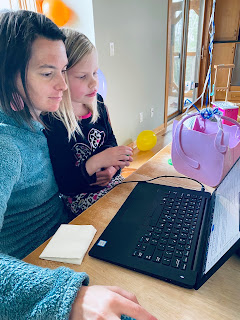By Samantha Grant
 Youth work, like all other fields, has been flipped on its head this year. Many youth workers are facing a reality in which their own children constantly surround them. Morphing from youth worker into classroom teacher, screen time warden and maker of chore charts.
Youth work, like all other fields, has been flipped on its head this year. Many youth workers are facing a reality in which their own children constantly surround them. Morphing from youth worker into classroom teacher, screen time warden and maker of chore charts.
I am right there with many of you - working from home and trying to manage home schooling for three children of my own. Social media, blogs and online articles tell me about fun and creative tasks I can use to stimulate them, but they overwhelmed me. I may or may not have sobbed in my closet with a bag of chocolate chips until I realized that I do not have to do it all myself.
I am not one to create Pinterest-worthy projects, but I can help you to build and evaluate strong programs. If you, like me, lack craftiness, I encourage you to pause, then get back to planning new, exciting youth programs. Intentional programs need intentional planning.
I wish you all the best planning. I would love to hear about your visioning and planning. Do you have a program planning strategy that gets you engaged? Share your ideas in the comments.
You are welcome to comment on this blog post. We encourage civil discourse, including spirited disagreement. We will delete comments that contain profanity, pornography or hate speech--any remarks that attack or demean people because of their sex, race, ethnic group, etc.--as well as spam.
 Youth work, like all other fields, has been flipped on its head this year. Many youth workers are facing a reality in which their own children constantly surround them. Morphing from youth worker into classroom teacher, screen time warden and maker of chore charts.
Youth work, like all other fields, has been flipped on its head this year. Many youth workers are facing a reality in which their own children constantly surround them. Morphing from youth worker into classroom teacher, screen time warden and maker of chore charts.I am right there with many of you - working from home and trying to manage home schooling for three children of my own. Social media, blogs and online articles tell me about fun and creative tasks I can use to stimulate them, but they overwhelmed me. I may or may not have sobbed in my closet with a bag of chocolate chips until I realized that I do not have to do it all myself.
I am not one to create Pinterest-worthy projects, but I can help you to build and evaluate strong programs. If you, like me, lack craftiness, I encourage you to pause, then get back to planning new, exciting youth programs. Intentional programs need intentional planning.
Here are four ideas that can help you jump-start some great planning:
Create a vision board for your program. Vision boards are commonly used for reaching for life goals. Try the same thing for your program. What is your greatest hope for youth in your program? Knowing this will help you to develop a program that is rooted in your youth work values. Maybe you care about building future scientists who are critical thinkers, or maybe you want to engage youth to become global citizens. Your vision board can be an inspiring visual to help you think about what matters most. (Bonus points: have youth- or your own children- complete a vision board for themselves at home.)
Good programs and happy families take intentional planning - Develop a program plan built on good outcomes. What do you want youth to learn in your program? Here I want you to focus on what you want youth to learn, not on how they will learn it. Too often as youth workers, we jump to the activities. I want you to pause, use these resources as a guide, and think about the learning that you want to happen.
- Take your vision and your outcomes and start to build the program. How can you translate your vision and your outcomes into meaningful activities? Learn from my colleague Margo about an innovative way to program plan.
- You also can start to design evaluation metrics for your program before it starts. I have developed a tip sheet with five parts to an evaluation plan. How will you know that your program is successful? Think about how you can measure your efforts. You might want to learn more about survey design or focus groups. Try something different and make a plan for a new way to collect data for your future programs.
I wish you all the best planning. I would love to hear about your visioning and planning. Do you have a program planning strategy that gets you engaged? Share your ideas in the comments.
-- Samantha Grant, evaluation director
You are welcome to comment on this blog post. We encourage civil discourse, including spirited disagreement. We will delete comments that contain profanity, pornography or hate speech--any remarks that attack or demean people because of their sex, race, ethnic group, etc.--as well as spam.
Awesome! Thank you for this great blog post!
ReplyDeleteThank you for the great tips and resources, Sam! This inspired me to revisit Wiggins' Six Facets of Understanding - another tool I find inspiring and helpful when program planning. Thought I'd share a quick link that popped up: https://www.teachthought.com/critical-thinking/6-facets-of-understanding-definition/
ReplyDeleteThank you for the great tips and resources, Sam!
ReplyDelete